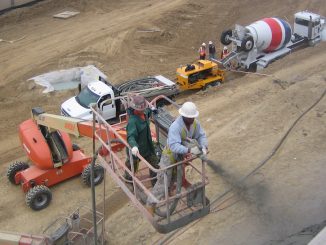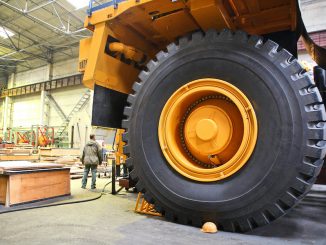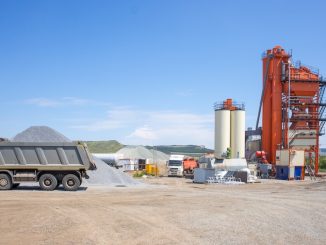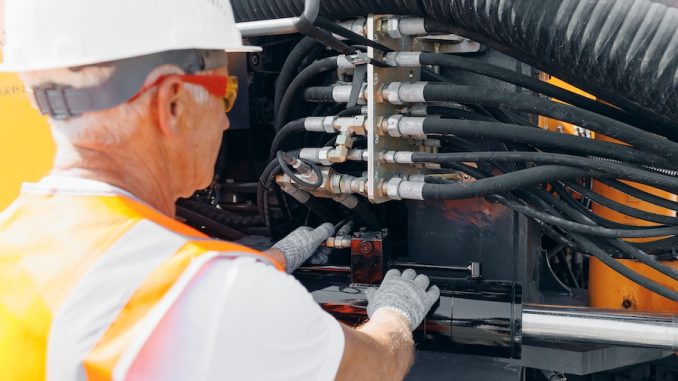
View the complete article here.
Hydraulic systems are the dynamic force behind the power of earthmoving and excavation equipment, crucial for the most important construction tasks. In this guide, we’re going to cover the essentials of hydraulic systems—detailing their core components—such as pumps, valves, cylinders, hoses, and fluids, and explaining their critical functions. We will also discuss the pivotal role hydraulics play in various machinery, from excavators to bulldozers and backhoe loaders—guiding you through the processes of maintenance and troubleshooting to keep your equipment in peak condition.
Understanding Hydraulic Systems
At the heart of all earthmoving and excavation equipment is a hydraulic system that acts much like a circulatory system in a living organism. It is a complex network of components working in unison to transfer power from the engine to the working parts of the machinery. To fully grasp the common issues that can arise within these systems, it’s essential to understand their basic components and their functions.
Basic Components of Hydraulic Systems
The basic components of hydraulic systems include:
- Pumps: These are the workhorses of the hydraulic system, providing the force needed to move the hydraulic fluid through the system. The pump converts mechanical energy from the engine into hydraulic energy.
- Valves: Hydraulic valves control the flow of hydraulic fluid within the system, directing it to specific components at the required time and in the correct amount. They play a critical role in managing the direction and pressure of the fluid.
- Cylinders: These are the actuators that convert hydraulic energy back into mechanical energy. When hydraulic fluid is pumped into a cylinder, it pushes against a piston—creating movement that can be used to lift, push, or move parts of the equipment.
- Hoses and Lines: Hoses and steel lines transport the hydraulic fluid to different parts of the system. Hoses are flexible and can absorb some of the vibrations and shocks that the machinery may experience during operation, while steel lines are used where less flexibility is needed.
- Hydraulic Fluid: This is the medium that transfers the power throughout the system. It also lubricates the system’s components, helps to keep them cool, and can act as a sealant.
The Role of Hydraulics in Earthmoving Equipment
Hydraulics are integral to the operation of various types of earthmoving equipment, each serving a unique function:
- Excavators: These machines use hydraulics to power the boom, arm, and bucket. These components require precise control and powerful forces to dig, lift, and move material.
- Bulldozers: Hydraulic systems in bulldozers operate the blade and ripper. They provide the necessary power to push large quantities of soil, sand, rubble, or other materials during construction work.
- Backhoe Loaders: These versatile machines have a loader-style bucket on the front and a backhoe on the back. Hydraulics are used to control both ends—allowing for digging, trenching, back-filling, and material handling.
- Wheel Loaders: Hydraulics in wheel loaders power the bucket or front-mounted scoop. It’s essential for lifting and transporting materials over short distances.
- Motor Graders: These machines have a long blade used for flattening surfaces. The hydraulic system adjusts the blade’s height and angle, ensuring precision in grading and leveling.
- Articulated Haulers: In these vehicles, hydraulics are used not only for dumping the load but also for steering the front wheels—which is vital for maneuvering heavy loads on uneven terrain.
Understanding how these components function and interact with one another allows technicians and operators to better diagnose and resolve the hydraulic issues that may arise—keeping their earthmoving equipment running efficiently and effectively.
Preventative Maintenance
The most effective way to avoid hydraulic issues is through proactive and regular maintenance. Preventative maintenance not only extends the lifespan of your earthmoving equipment but also ensures it operates at peak efficiency, reducing the risk of unexpected downtime and costly repairs.
With the complexity of hydraulic systems, even small problems can quickly escalate to major failures. Regular maintenance checks act as a form of quality assurance that helps catch issues before they become serious. These checks can identify early signs of wear-and-tear, contamination, and other potential problems—allowing for timely interventions.
Maintenance Schedule Recommendations
Developing and adhering to a maintenance schedule is crucial. Here are some general guidelines to follow:
- Daily checks: Before starting the equipment each day—check for visible signs of leaks, damaged hoses, and loose fittings. Ensure that the hydraulic fluid level is within the recommended range.
- Monthly: Conduct more thorough inspections monthly—including checking the condition of hydraulic cylinders, valves, and pumps for any signs of damage or wear.
- Semi-annual services: Every six months—perform a comprehensive service that includes changing the hydraulic fluid, cleaning or replacing filters, and inspecting the hydraulic lines for any signs of fatigue or damage.
- Annual reviews: Once a year, have a certified technician perform an in-depth analysis of the entire hydraulic system—including pressure testing and flow testing—to ensure everything is operating as it should.
Checking Hydraulic Fluid Levels and Quality
The hydraulic fluid is the medium through which power is transferred in the system. It’s essential to regularly check both the level and the quality of this fluid.
Check the hydraulic fluid level with the equipment in a neutral position and the hydraulic oil at operating temperature. Low fluid levels can lead to cavitation and damage to the hydraulic pump, while overfilling can cause excessive pressure and leaks.
The quality of the hydraulic fluid should be checked for signs of contamination—such as water, air, or particulate matter. Contaminated fluid can degrade the performance of the hydraulic system and lead to component failure. Utilize fluid sampling and analysis services to detect contaminants and determine the health of your hydraulic fluid.
Keep in mind that the specific maintenance schedule for your equipment may vary based on the manufacturer’s recommendations, the age of the equipment, and the conditions in which it operates. Always refer to the operator’s manual for the most accurate maintenance information for your particular models.
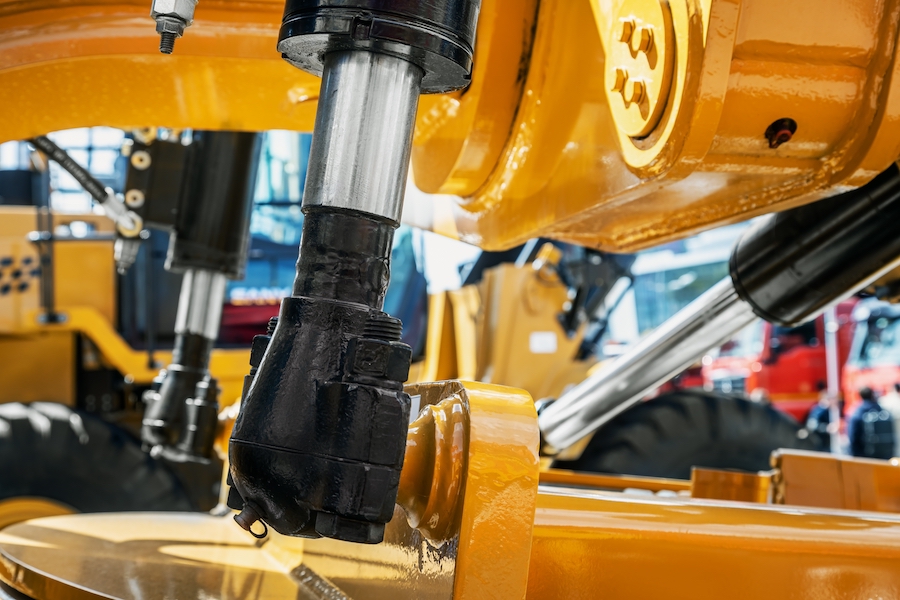
Diagnosing Hydraulic Issues
Efficient diagnosis is the first step in resolving hydraulic issues in earthmoving equipment. Recognizing the symptoms early can prevent minor issues from escalating into major breakdowns. Here are common symptoms to look out for:
- Loss of power: A significant loss of power in the equipment’s hydraulic components could indicate a problem with the hydraulic pump or its drive system. It might also result from air entrainment in the hydraulic fluid, which compromises the fluid’s ability to efficiently transmit power.
- Slow operation: If the hydraulic-operated components of your equipment move slower than usual—it might be due to low hydraulic fluid levels, a clogged filter, or faulty valves that are restricting the flow of the hydraulic fluid.
- Noisy operation: Unusual noises such as whining, knocking, or banging from the hydraulic system are often signs of cavitation or aeration within the hydraulic fluid. These can be caused by leaks that allow air to enter the system or by fluid levels that are too low.
- Leaks: Hydraulic fluid leaks are not just messy—they can lead to serious issues. Leaks can occur at seals, hoses, or connections and can drastically affect the pressure and efficiency of the hydraulic system.
Tools and Equipment Needed for Diagnosis
To accurately diagnose these symptoms, having the right tools and equipment is essential. Here’s what you’ll likely need:
- Fluid level gauge: This tool helps measure the hydraulic fluid level in the reservoir, ensuring it’s within the operational range.
- Hydraulic pressure gauges: These gauges are critical for measuring the hydraulic pressure in different parts of the system to ensure it matches the manufacturer’s specifications.
- Thermometer or infrared thermal gun: Heat is a byproduct of inefficiency in a hydraulic system. Measuring the temperature of components can help locate a problem area.
- Flow meters: These devices determine the flow rate of the hydraulic fluid, which can help identify if the fluid is moving through the system as it should.
- Hydraulic test kits: These comprehensive kits often include various gauges, sensors, and adapters to test different aspects of the hydraulic system.
- Visual inspection tools: Mirrors, magnifying glasses, and inspection cameras can help you spot leaks, cracks, and wear in less accessible areas.
- Fluid analysis kit: A fluid analysis kit can test the hydraulic fluid for contamination, which can cause many of the issues outlined above.
Equipped with these tools and a keen eye for symptoms, operators and technicians can quickly identify and address the root causes of hydraulic issues.
Troubleshooting Steps for Common Problems
In earthmoving equipment, addressing hydraulic issues as quickly as possible is vital to maintaining operational efficiency and extending the life of the machinery.
Loss of Hydraulic Fluid Pressure: Causes and Solutions
The hydraulic system of earthmoving equipment is prone to issues that can hinder its operation. One prevalent issue is leaks in the system, which can lead to a loss of hydraulic pressure and reduced efficiency. Such leaks are often due to damaged hoses, seals, or fittings—which can wear out over time or due to exposure to tough conditions. Another issue that can affect the system’s performance is a worn or damaged hydraulic pump—if the pump cannot maintain adequate pressure, the system’s performance will falter.
Valve problems are also common—blocked or damaged valves can restrict the hydraulic fluid’s flow, leading to sluggish system response. In addition, air entrapment in the fluid can disrupt the system’s operations as air bubbles within the fluid can interfere with the smooth transfer of force.
Addressing these issues involves a systematic approach. Initially, it is vital to inspect the system for leaks and undertake necessary repairs or replacements of any compromised components. Testing the hydraulic pump for efficiency is crucial, and it should be replaced if it fails to meet performance standards. Ensuring that valves are not obstructed is another critical step—clean or replace blocked valves to maintain fluid flow and pressure. Lastly, it is essential to bleed the system to eliminate any trapped air—ensuring that the hydraulic fluid circulates correctly and maintains system performance.
Overheating Hydraulic Systems: Preventive Measures and Fixes
To prevent the overheating of hydraulic systems in earthmoving equipment, implementing preventive measures is essential. It is crucial to ensure the fluid level and quality are maintained, as insufficient or degraded fluid can lead to increased friction and heat. In addition, the hydraulic fluid coolers and filters should be regularly cleaned to facilitate optimal heat dissipation and maintain fluid integrity. Operators should also monitor system operation closely to prevent overloading, which can cause the system to generate excessive heat.
When it comes to fixes for an overheating system, several steps should be taken. Firstly, if overheating occurs, it is important to check and clean the heat exchanger—as a clogged exchanger can impair the system’s ability to cool down. Secondly, any old or degraded hydraulic fluid that is no longer effective at transferring heat should be replaced to enhance the system’s cooling capacity. Lastly, it is recommended to inspect and replace worn components that may force the system to exert more effort than usual, which may lead to the generation of excess heat.
Contaminated Hydraulic Fluid: How to Clean and Prevent Contamination
Contaminated hydraulic fluid can significantly hinder the performance of earthmoving equipment, making it imperative to both clean existing contaminants and prevent future contamination. For cleaning the hydraulic fluid, a filtration system should be employed to remove particulate contaminants from the fluid—ensuring it remains pure and effective. In instances where contamination is severe, undertaking a complete fluid change may be necessary to restore system cleanliness.
As for prevention, it is essential to implement proper sealing and filtration systems to protect against contaminants entering the hydraulic fluid. Utilizing high-quality hydraulic fluid that possesses contamination control properties can greatly reduce the risk of contamination. In addition, conducting regular fluid analysis is a proactive step that can detect contamination early on—allowing for swift action to mitigate any potential damage to the hydraulic system.
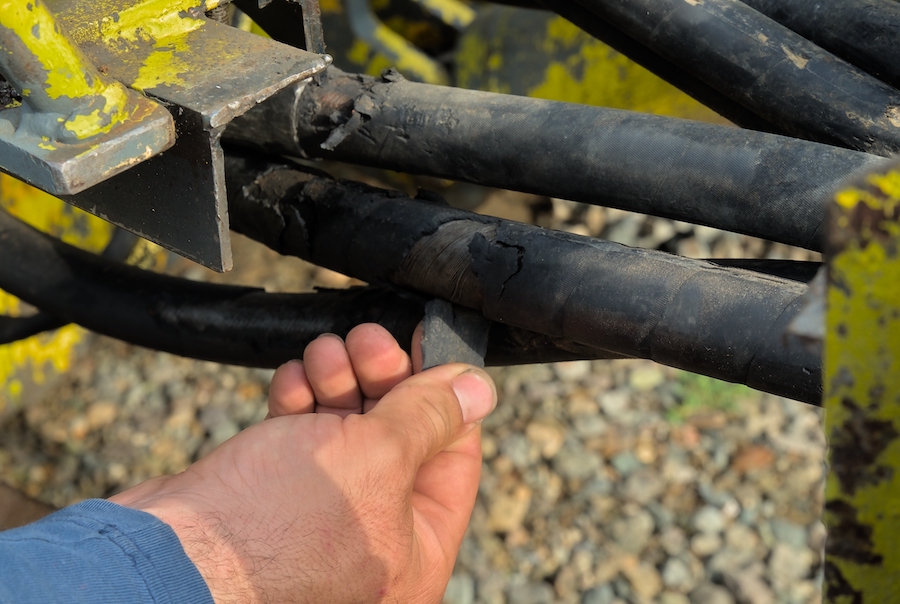
Hydraulic Cylinder Leaks and Repairs
Detecting and repairing leaks in hydraulic cylinders are critical to maintaining the integrity and performance of earthmoving equipment. For leak detection, a visual inspection should be the first step—which involves checking for wet spots or drips on and around the hydraulic cylinder which usually indicate a leak. In addition, using a pressure gauge to test if the cylinder is maintaining the required pressure can help confirm a leak’s presence and severity.
When it comes to repairs, the initial focus should be on the cylinder’s seals and gaskets. Replace worn seals or gaskets as they are often the culprits behind minor leaks. However, if the leak stems from physical damage to the hydraulic cylinder itself—more extensive repairs may be required. It may be necessary to repair or replace the cylinder barrel or rod if they are damaged, to restore the cylinder’s functionality and prevent further leakage.
Troubleshooting Valve Block Problems
Troubleshooting valve block problems in hydraulic systems is a critical aspect of equipment maintenance. The symptoms of valve block issues can be quite noticeable and may include erratic operation or unexpected movement of the machinery, as well as pressure fluctuations within the hydraulic system. These symptoms suggest that the hydraulic fluid is not being directed efficiently or consistently.
The troubleshooting process begins with a thorough inspection of the valve block for any signs of wear or damage that could be causing the issues. This includes checking for any visible damage or wear that might impede the valves’ function. In addition, it’s important to check the electrical signals to the valves—as faulty wiring or connections can lead to improper valve operation. If the valves are found to be sticky or not operating properly, they should be cleaned or replaced. This ensures that the hydraulic fluid is properly controlled and directed, restoring the system to its proper function. Regular maintenance and prompt attention to these symptoms can prevent more significant problems and potential equipment failure.
Electrical Issues Affecting Hydraulic Systems
Electrical issues can significantly impact the functionality of hydraulic systems in earthmoving equipment. Common electrical issues that may arise include faulty sensors or switches, which can lead to incorrect readings and responses—wiring faults, which can disrupt electrical flow—and solenoid valve failures, which can prevent valves from operating as intended, thus affecting the hydraulic functions they control.
Addressing these issues involves a series of diagnostic steps. Initially, a multimeter should be used to test for continuity and voltage in the electrical components to ensure that the current is flowing correctly and that the voltage levels are within specified ranges. The wiring should be inspected for damage or corrosion, and any defects found should be repaired to restore proper electrical connections. Finally, it’s crucial to test or replace faulty solenoids that control valves and other hydraulic components. Solenoids are essential for the operation of the hydraulic system, and ensuring they are functioning correctly is vital for the equipment’s performance.
Conclusion
When troubleshooting hydraulic issues in earthmoving and excavation equipment, recognizing when to seek professional help is crucial. Certain problems, due to their complexity, require professional expertise to avoid the considerable risks associated with DIY repairs on such intricate systems. It is important to address these hydraulic issues promptly, as timely intervention is vital not only for the safety of the operators but also for the longevity of the equipment.
View the complete article here.
What are the basic components of hydraulic systems in earthmoving equipment?
The basic components include pumps, valves, cylinders, hoses, and hydraulic fluid, each serving a crucial role in transferring power and facilitating the machinery's functions.
How can operators prevent and address hydraulic issues in earthmoving equipment?
Operators can prevent hydraulic issues through regular maintenance, including daily checks, monthly inspections, semi-annual services, and annual reviews, as well as diagnosing symptoms early and addressing them with the right tools and equipment.






































